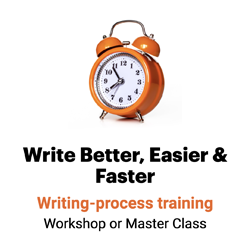Templates more effective than brainstorming, free association
Can creativity be templated?

Yes it can, according to a team of Israeli researchers.
In 1999, the researchers studied 200 ads that had been award winners or finalists in top advertising competitions. The researchers found that nearly nine in 10 of the ads could be classified into six templates.
Next, they studied 200 less successful ads — those that had not earned awards. The researchers found that only 2.5% of those ads could be classified into templates.
“The surprising lesson of this story: Highly creative ads are more predictable than uncreative ones,” write Chip and Dan Heath in Made to Stick. “It’s like Tolstoy’s quote: ‘All happy families resemble each other, but each unhappy family is unhappy in its own way.’ All creative ads resemble one another, but each loser is uncreative in its own way.”
Traditionally, creative idea-generation techniques have focused on a lack of system and logic. We try to brainstorm as many different ideas as we can. We say, “there are no bad ideas.” We bring in diverse opinions through focus groups and free association.
But what if we’re wrong?
Find the patterns.
A better approach, according to the Israeli researchers, is to identify patterns in successful communications and brainstorm ways to implement those patterns.
This approach itself follows a pattern in creative thinking.
The researchers found that nearly nine in 10 of the ads could be classified into six templates.
Next time you’re developing creative campaign, use these proven templates to jump-start your ideas:
1. Pictoral analogy
This approach merges or replaces your central image with another one. An ad for the French Open Tennis Championship, for instance, featured a tennis ball shaped like a croissant.
You can see the thinking behind this ad:
What images depict tennis? What images depict France? How do I merge the two?
More than one-third of the top-rated ads in the study used this template.
2. Consequences
For this approach, point out unexpected consequences of a product attribute. A commercial for car loudspeakers, for instance, showed a bridge on the verge of collapse when the speakers of a car parked on it were turned way up.
To use this template, ask:
What’s a key feature of our product or service? How can we exaggerate the consequences of using — or failing to use — this feature?
More than 18% of the top-rated ads in the study used this template.
3. Extreme situation
This approach shows a product performing under unusual circumstances or exaggerates a product’s features to the point of absurdity. A commercial for locks, for instance, shows a woman barking at burglars to scare them away.
For this approach, you say:
You don’t have to buy our product. Alternatives for achieving the same results include [something ridiculous].
Some 12% of the top-rated ads in the study used this template.
4. Competition
For this approach, show your product or service winning in competition with something else. One ad, for instance, shows a person trying to decide whether to answer a ringing phone or finish eating the advertised cereal.
Nearly 10% of the top-rated ads in the study used this template.
5. Dimensionality alteration
A woman is arguing with her husband for canceling his life insurance. In a moment it becomes clear that the scene occurs after he has died, during a séance.
For dimensionality alteration, manipulate a product’s relationship with time, space or some other aspect of its environment.
Nearly 10% of the top-rated ads in the study used this template.
6. Interactive experiment
For this template, you invite the viewer to perform or to imagine performing an experiment that demonstrates a need or problem that your product or service can solve.
One ad, for example, included a large black square. When the audience member shakes her head over the square, she can see that she needs dandruff shampoo.
How can you demonstrate the need for your solution in action?
About 6% of the top-rated ads in the study used this template.
Can creativity be taught?
Next, the Israeli researchers took a group of novices — people with no advertising experience at all — and broke them into three teams.
- Team One trained for two hours on how to use the six creative templates.
- Team Two learned about classic idea-generation techniques like free-association and brainstorming.
- Team Three received no training at all.
Those who’d learned the templates created more creative, memorable and effective ads than the other two teams.
The researchers tested the top ads with consumers. Team One’s ads were rated 50% more creative and 55% more effective at creating a positive attitude toward the products advertised.
The next day, the customers were asked to recall the ads. Team One’s ads were remembered 45% more often than Team Two’s — and twice as often as Team Three’s.
Why reinvent the wheel?
Call it thinking inside the box: The irony is that frameworks, formulas and templates like these can actually help you come up with more effective creative ideas than “free-thinking” techniques.
_____
Sources: Jacob Goldenberg, David Mazursky, and Sorin Solomon, “The Fundamental Templates of Quality Ads,” Marketing Science 18 (1999), 333-51
Chip Heath and Dan Heath, Made to Stick: Why Some Ideas Survive and Others Die, Random House, 2007

I’ve read Made To Stick and created my own “template” based on the ideas in the book. While I have a BA in Technical Communication and a Minor in Creative writing, sometimes I forget aspects of great, persuasive writing and a review of my Made To Stick template and checklist is invaluable.
I’d also like to add that I’ve tried several Artificial Intelligence writing apps and found them next to useless. Essentially, they are glorified article spinners, stringing together rewritten sentences and paragraphs into “surfacy” and flat presentations of other people’s work. Sadly disappointing.
Writing is an art form, as complex and exhilarating as sculpture or oil painting. There are only two ways to learn to write well. Taking classes with an experienced writer as you do here, or reading a diverse and creative selection of writing styles. And definitely add poetry to that list; writing pared to the quick of a nail.